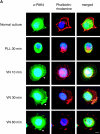P21-activated kinase 4 interacts with integrin alpha v beta 5 and regulates alpha v beta 5-mediated cell migration
- PMID: 12356872
- PMCID: PMC2173231
- DOI: 10.1083/jcb.200207008
P21-activated kinase 4 interacts with integrin alpha v beta 5 and regulates alpha v beta 5-mediated cell migration
Abstract
p21-activated kinase 1 (PAK1) can affect cell migration (Price et al., 1998; del Pozo et al., 2000) and modulate myosin light chain kinase and LIM kinase, which are components of the cellular motility machinery (Edwards, D.C., L.C. Sanders, G.M. Bokoch, and G.N. Gill. 1999. Nature Cell Biol. 1:253-259; Sanders, L.C., F. Matsumura, G.M. Bokoch, and P. de Lanerolle. 1999. SCIENCE: 283:2083-2085). We here present a novel cell motility pathway by demonstrating that PAK4 directly interacts with an integrin intracellular domain and regulates carcinoma cell motility in an integrin-specific manner. Yeast two-hybrid screening identified PAK4 binding to the cytoplasmic domain of the integrin beta 5 subunit, an association that was also found in mammalian cells between endogenous PAK4 and integrin alpha v beta 5. Furthermore, we mapped the PAK4 binding to the membrane-proximal region of integrin beta 5, and identified an integrin-binding domain at aa 505-530 in the COOH terminus of PAK4. Importantly, engagement of integrin alpha v beta 5 by cell attachment to vitronectin led to a redistribution of PAK4 from the cytosol to dynamic lamellipodial structures where PAK4 colocalized with integrin alpha v beta 5. Functionally, PAK4 induced integrin alpha v beta 5-mediated, but not beta1-mediated, human breast carcinoma cell migration, while no changes in integrin cell surface expression levels were observed. In conclusion, our results demonstrate that PAK4 interacts with integrin alpha v beta 5 and selectively promotes integrin alpha v beta 5-mediated cell migration.
Figures













Similar articles
-
p21-activated kinase 4 phosphorylation of integrin beta5 Ser-759 and Ser-762 regulates cell migration.J Biol Chem. 2010 Jul 30;285(31):23699-710. doi: 10.1074/jbc.M110.123497. Epub 2010 May 27. J Biol Chem. 2010. PMID: 20507994 Free PMC article.
-
Integrin-mediated cell attachment induces a PAK4-dependent feedback loop regulating cell adhesion through modified integrin alpha v beta 5 clustering and turnover.Mol Biol Cell. 2010 Oct 1;21(19):3317-29. doi: 10.1091/mbc.E10-03-0245. Epub 2010 Aug 18. Mol Biol Cell. 2010. PMID: 20719960 Free PMC article.
-
The pattern of enhancement of Src kinase activity on platelet-derived growth factor stimulation of glioblastoma cells is affected by the integrin engaged.J Biol Chem. 2003 Oct 10;278(41):39882-91. doi: 10.1074/jbc.M304685200. Epub 2003 Jul 24. J Biol Chem. 2003. PMID: 12881526
-
Understanding the molecular basis of cell migration; implications for clinical therapy in multiple sclerosis.Clin Sci (Lond). 1997 Feb;92(2):113-22. doi: 10.1042/cs0920113. Clin Sci (Lond). 1997. PMID: 9059311 Review.
-
The role of alpha(v)beta(3) in prostate cancer progression.Neoplasia. 2002 May-Jun;4(3):191-4. doi: 10.1038/sj.neo.7900224. Neoplasia. 2002. PMID: 11988838 Free PMC article. Review.
Cited by
-
p21-activated kinase 4 phosphorylation of integrin beta5 Ser-759 and Ser-762 regulates cell migration.J Biol Chem. 2010 Jul 30;285(31):23699-710. doi: 10.1074/jbc.M110.123497. Epub 2010 May 27. J Biol Chem. 2010. PMID: 20507994 Free PMC article.
-
Republished: tracing PAKs from GI inflammation to cancer.Postgrad Med J. 2014 Nov;90(1069):657-68. doi: 10.1136/postgradmedj-2014-306768rep. Postgrad Med J. 2014. PMID: 25335797 Free PMC article.
-
miR-24 triggers epidermal differentiation by controlling actin adhesion and cell migration.J Cell Biol. 2012 Oct 15;199(2):347-63. doi: 10.1083/jcb.201203134. J Cell Biol. 2012. PMID: 23071155 Free PMC article.
-
The Cdc42 Effector Kinase PAK4 Localizes to Cell-Cell Junctions and Contributes to Establishing Cell Polarity.PLoS One. 2015 Jun 11;10(6):e0129634. doi: 10.1371/journal.pone.0129634. eCollection 2015. PLoS One. 2015. PMID: 26068882 Free PMC article.
-
A role for LIM kinase in cancer invasion.Proc Natl Acad Sci U S A. 2003 Jun 10;100(12):7247-52. doi: 10.1073/pnas.1232344100. Epub 2003 May 30. Proc Natl Acad Sci U S A. 2003. PMID: 12777619 Free PMC article.
References
-
- Bagrodia, S., and R.A. Cerione. 1999. PAK to the future. Trends Cell Biol. 9:350–355. - PubMed
-
- Bar-Sagi, D., and A. Hall. 2000. Ras and Rho GTPases: a family reunion. Cell. 103:227–238. - PubMed
-
- Bodeau, A.L., A.L. Berrier, A.M. Mastrangelo, R. Martinez, and S.E. LaFlamme. 2001. A functional comparison of mutations in integrin β cytoplasmic domains: effects on the regulation of tyrosine phosphorylation, cell spreading, cell attachment, and β1 integrin conformation. J. Cell Sci. 114:2795–2807. - PubMed
Publication types
MeSH terms
Substances
LinkOut - more resources
Full Text Sources
Other Literature Sources
Molecular Biology Databases
Research Materials

